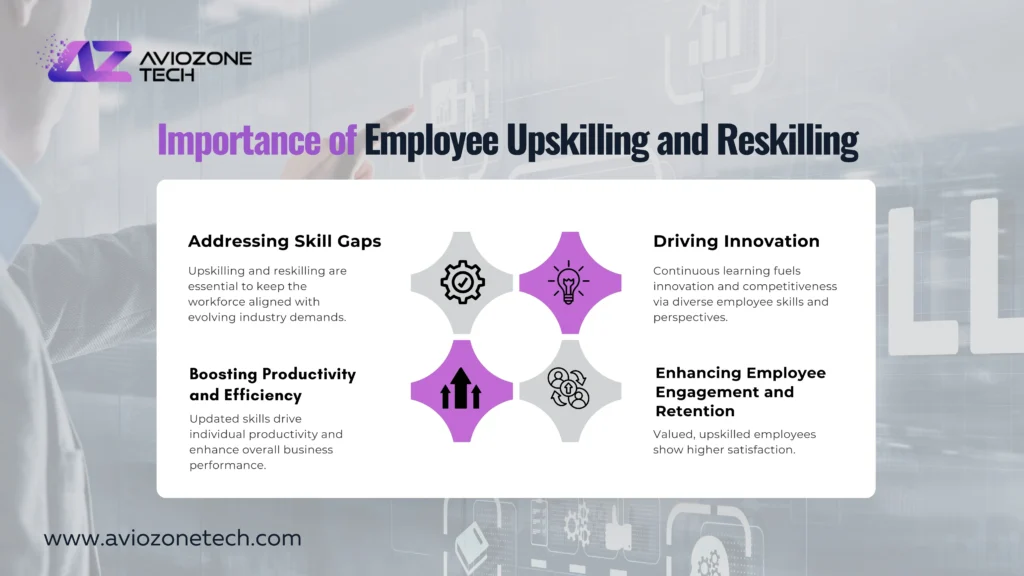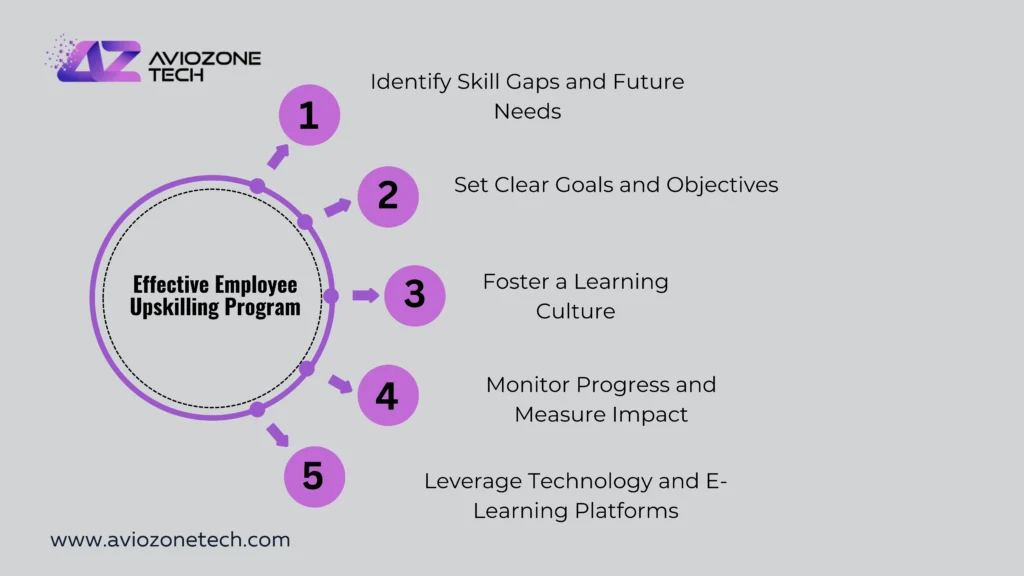Unlocking Business Growth Through Employee Upskilling and Reskilling
Agility, innovation and competitiveness are required in the rapidly changing business landscape. Employee upskilling and reskilling is among the most efficient ways to attain this objective. In addition to enhancing their capabilities, investing in continuous workforce development drives business growth. In this article, we will discuss the importance of employee upskilling and reskilling, why they benefit employee ideas for good upskilling programs and examples from companies where these strategies have worked wonders.
Importance of Employee Upskilling and Reskilling

The significance of upskilling and reskilling cannot be overemphasized in light of a constantly changing job market together with technological advancements. These are exercises that entail retraining workers so that they can gain new competencies or shifting them to different roles within the organization.
Here are several reasons why these strategies are crucial for business growth:
1. Addressing Skill Gaps
As industries evolve, certain skills become obsolete while new ones emerge. Upskilling and reskilling help bridge the gap between the current skill set of employees and the skills required to meet future business demands. This proactive approach ensures that your workforce remains relevant and capable of tackling new challenges.
2. Enhancing Employee Engagement and Retention
Employees who feel valued and see opportunities for growth within the organization are more likely to stay engaged and loyal. Offering upskilling and reskilling programs demonstrates a commitment to their professional development, leading to higher job satisfaction and reduced turnover rates.
3. Driving Innovation
A well-rounded and continually learning workforce is more likely to contribute to innovative solutions and ideas. By fostering a culture of continuous learning, companies can leverage the diverse skills and perspectives of their employees to drive innovation and maintain a competitive edge.
4. Boosting Productivity and Efficiency
Employees equipped with the latest skills and knowledge can perform their tasks more efficiently and effectively. This not only enhances individual productivity but also improves overall business performance.
5. Preparing for Technological Advancements
With the advent of artificial intelligence, automation and other technological advancements, many traditional job roles are undergoing significant changes. Upskilling and reskilling enable employees to adapt to these changes, ensuring that the organization remains competitive in the digital age.
How Does an Employee Benefit from Upskilling?
The advantages of upskilling extend beyond organizational benefits, offering significant personal and professional growth opportunities for employees.
Here are some key ways in which employees benefit from upskilling:
1. Career Advancement
Upskilling opens up new career paths and opportunities for employees. By acquiring new skills, they can qualify for promotions, take on more responsibilities and explore different roles within the organization.
2. Job Security
In an uncertain job market, having a diverse skill set can provide employees with a sense of security. They become more adaptable and capable of transitioning to different roles if needed, reducing the risk of redundancy.
3. Increased Earning Potential
With enhanced skills and qualifications, employees can command higher salaries and benefits. Upskilling makes them more valuable to the organization, which can lead to better compensation packages.
4. Personal Growth and Satisfaction
Continuous learning fosters a sense of accomplishment and personal growth. Employees who engage in upskilling often feel more confident and satisfied with their careers, contributing to their overall well-being.
5. Staying Relevant
In a fast-paced and ever-changing job market, staying relevant is crucial. Upskilling ensures that employees remain up-to-date with industry trends and technologies, making them indispensable assets to their organizations.
Disadvantages of upskilling
Upskilling, the process of learning new skills or improving existing ones to enhance career prospects, certainly offers numerous advantages.
However, there are also some potential disadvantages to consider:
1. Time and Commitment
Upskilling often requires a significant time commitment, which can be challenging for individuals who already have busy schedules with work and personal commitments. Balancing learning with other responsibilities can be difficult.
2. Cost
Depending on the method chosen for upskilling (such as courses, workshops, or certifications), there can be considerable financial costs involved. This can be a barrier for individuals with limited financial resources.
3. Risk of Overqualification
Upskilling may lead to overqualification, where individuals become more skilled than necessary for their current job roles. This can potentially lead to dissatisfaction or difficulty finding suitable employment opportunities.
4. Stress and Pressure
The pressure to continuously upskill to remain competitive in the job market can contribute to stress and anxiety for individuals, especially if they feel they are falling behind their peers or industry standards.
5. Lack of Immediate Return on Investment
It may take time to see the benefits of upskilling in terms of career advancement or increased earning potential. Some individuals may become discouraged if they do not see immediate results.
Implementing an Effective Employee Upskilling Program

To harness the full potential of upskilling, organizations need to implement well-structured and effective programs.
Here are the key steps to developing an impactful employee upskilling program:
1. Identify Skill Gaps and Future Needs
Begin by assessing the current skill levels of your employees and identifying gaps that need to be addressed. This involves understanding the future needs of your industry and aligning your upskilling efforts with those requirements.
2. Set Clear Goals and Objectives
Define the goals and objectives of your upskilling program. What specific skills do you want your employees to acquire? How will these skills contribute to the overall business strategy? Clear goals provide direction and help measure the success of the program.
3. Design Customized Training Programs
One-size-fits-all approaches rarely work in upskilling. Design customized training programs that cater to the unique needs and learning styles of your employees. This could involve a mix of online courses, workshops, on-the-job training, and mentorship programs.
4. Leverage Technology and E-Learning Platforms
Technology plays a crucial role in modern upskilling programs. Utilize e-learning platforms, virtual classrooms, and interactive tools to deliver training effectively. These platforms offer flexibility and accessibility, allowing employees to learn at their own pace.
5. Foster a Learning Culture
Creating a culture of continuous learning is essential for the success of your upskilling program. Encourage employees to take ownership of their development, provide regular feedback, and recognize their achievements. Leadership should also lead by example, demonstrating a commitment to learning.
6. Monitor Progress and Measure Impact
Regularly monitor the progress of your upskilling initiatives and measure their impact on both employees and the organization. Use metrics such as employee performance, engagement levels, and business outcomes to evaluate the effectiveness of the program. Adjust your strategies based on feedback and results.
For insightful strategies on navigating talent acquisition, explore our blog post on 10 Key Trends for Attracting and Retaining Top Talent.
Upskilling examples
To illustrate the impact of effective upskilling, lets look at some real-world examples of companies that have successfully implemented these programs:
Amazon
Amazon Upskilling 2025 initiative aims to upskill 100,000 employees by 2025. The program offers a variety of training opportunities, including technical skills, software engineering and cloud computing. Amazon commitment to upskilling has not only enhanced employee capabilities but also supported the company growth in new business areas.
IBM
IBM New Collar initiative focuses on reskilling employees for emerging technology roles that do not necessarily require traditional four-year degrees. The program offers apprenticeships, partnerships with community colleges, and on-the-job training. IBM approach has expanded its talent pool and allowed the company to fill critical roles in areas such as cybersecurity and cloud computing.
Google Grow with Google initiative provides free training and resources to help individuals and small businesses develop digital skills. While not limited to its employees, this program exemplifies Google’s commitment to upskilling the broader workforce. By equipping people with valuable skills, Google supports economic growth and fosters innovation.
Conclusion
In conclusion, employee upskilling and reskilling are vital strategies for unlocking business growth. By addressing skill gaps, enhancing employee engagement, driving innovation, boosting productivity and preparing for technological advancements, organizations can stay competitive and agile in a rapidly changing market.
Employees also stand to benefit significantly from upskilling, enjoying career advancement, job security, increased earning potential, personal growth and the ability to stay relevant.
Investing in employee development is not just a strategic business decision. it is a commitment to the growth and well-being of your workforce. As the business landscape continues to evolve, upskilling and reskilling will remain essential tools for achieving sustained success and growth.
FAQs
Ans: Upskilling involves training employees to enhance their current skills and acquire new ones related to their existing roles. Reskilling, on the other hand, involves training employees to transition into entirely new roles or functions within the organization.
Ans: Small businesses can implement upskilling programs by leveraging online courses, partnering with local educational institutions, and creating mentorship opportunities. Its also essential to foster a culture of continuous learning and encourage employees to take ownership of their development.
Ans: Common challenges include identifying the right skills to develop, securing sufficient resources and budget, and ensuring employee engagement and participation. Overcoming these challenges requires clear communication, strong leadership support, and a focus on creating relevant and accessible training opportunities.
Ans: Companies can measure the success of their upskilling programs by tracking key metrics such as employee performance, engagement levels, and business outcomes. Feedback from employees, completion rates of training programs, and the impact on overall productivity and innovation are also important indicators.
Ans: Leadership plays a crucial role in setting the tone for upskilling initiatives. Leaders must demonstrate a commitment to continuous learning, provide the necessary resources and support, and actively participate in and promote the upskilling efforts within the organization.
Ans: We provide training and mentorship to help employees improve their skills and grow in their careers. We also support their development by offering resources and encouraging them to attend industry events.







